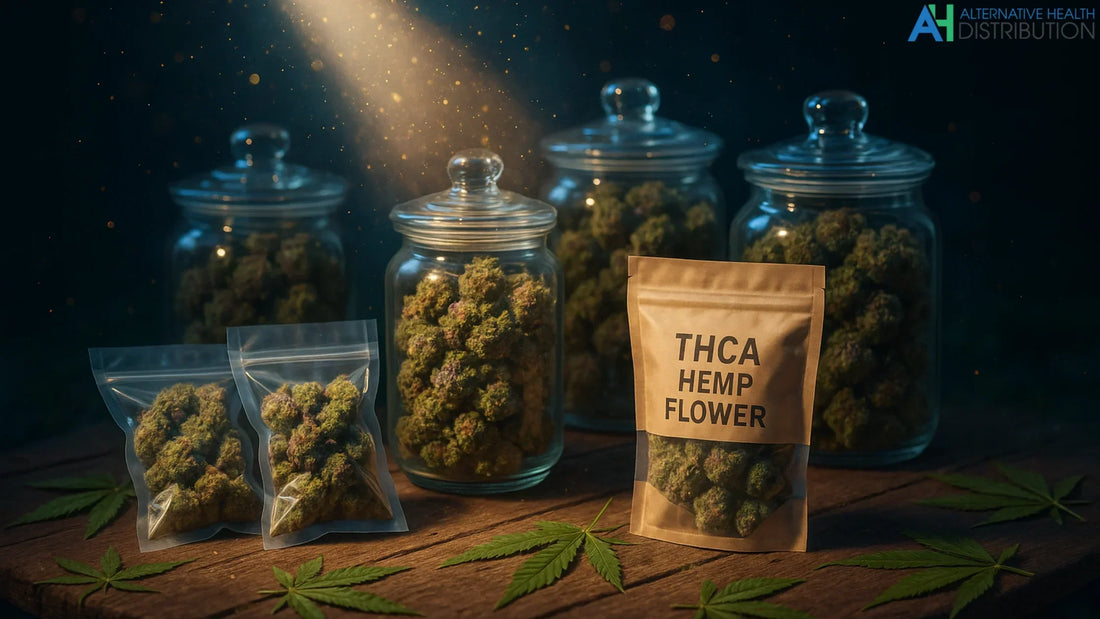
Don't Settle for Less: How to Pick High-Quality THCA Flower Fast
Share
In the rapidly expanding world of hemp products, high-quality THCA flower has emerged as the gold standard for cannabis connoisseurs seeking authentic experiences within legal boundaries. With countless options flooding the market, knowing how to distinguish premium THCA flower from inferior products has become crucial for both newcomers and seasoned enthusiasts.
THCA (tetrahydrocannabinolic acid) flower represents the raw, unheated form of cannabis that naturally converts to THC when exposed to heat through smoking or vaping. This legal loophole, thanks to the 2018 Farm Bill's definition of hemp as cannabis containing no more than 0.3% Delta-9 THC, has opened doors for consumers nationwide to access premium cannabis experiences legally.
Understanding What Makes THCA Flower High-Quality

High-quality THCA flower begins with its cultivation environment and methods. The finest THCA flowers come from regions with optimal growing conditions, where climate, soil composition, and traditional farming practices converge to create exceptional products.
The small Emerald Triangle farms of Northern California exemplify this perfect terroir. Humboldt, Mendocino, and Trinity counties combine cool nights, sun-soaked days, and fertile soil to create flower with unmatched potency and flavor.
Sun-grown cultivation plays a pivotal role in producing superior THCA flower. Unlike warehouse operations that rely on artificial lighting, outdoor cultivation under natural sunlight boosts terpene production – the aromatic compounds responsible for each strain's unique flavor profile and effects. This natural approach results in richer, more complex flavor profiles that simply cannot be replicated in indoor facilities.
Visual Indicators of Premium THCA Flower
When selecting high-quality THCA flower, your eyes provide the first line of quality assessment. Premium buds display vibrant colors ranging from deep forest greens to purple hues, often accented with bright orange or amber pistils. The surface should be generously coated with crystalline trichomes that give the flower a frosty, almost glittering appearance.
Structure matters significantly in quality assessment. Well-cultivated THCA flower maintains its shape without being overly dense or fluffy. The buds should feel slightly sticky to the touch due to resin content, but not wet or overly dry. Properly cured flower springs back when gently squeezed, indicating optimal moisture content.
Avoid flowers that appear brown, yellow, or contain visible seeds, as these indicate poor growing conditions, improper curing, or hermaphroditic plants. Similarly, flowers with excessive stem content or loose, airy structures often come from inferior cultivation practices.
The Importance of Aroma and Terpene Profiles
A high-quality THCA flower's aroma tells the complete story of its cultivation and curing process. Premium flowers release complex, layered scents that can range from citrusy and piney to earthy and sweet, depending on their terpene profile.
Fresh, potent aromas indicate proper curing and storage. The THCA strains with rich terpene profiles deliver not only exceptional aroma but also enhanced effects through the entourage effect.
Terpenes not only contribute to aroma but also influence the overall experience through what's known as the entourage effect. High-quality cultivators understand this relationship and carefully preserve terpene content through proper harvesting timing and curing processes.
Cultivation Methods That Matter
The cultivation method significantly impacts high-quality THCA flower production. Organic growing practices eliminate harmful chemicals while promoting robust plant health and superior flavor development. Premium producers utilize regenerative farming techniques, including cover crops and composting, which rejuvenate soil season after season.
Integrated pest management systems, where beneficial insects and birds control pests naturally, eliminate the need for chemical pesticides. This approach not only produces cleaner flower but also allows plants to develop their full genetic potential without chemical interference.
Small-batch cultivation often produces superior results compared to large-scale operations. Smaller farms can provide individual attention to each plant, monitoring development closely and harvesting at optimal times. This artisanal approach, perfected over decades by experienced cultivators, consistently yields exceptional products.
Laboratory Testing and Compliance

Legitimate lab-tested THCA flower and vape pens come with COAs (Certificates of Analysis) showing cannabinoid levels, terpenes, and safety tests. These ensure compliance with hemp laws while guaranteeing purity.
Testing should also screen for pesticides, heavy metals, microbials, and residual solvents. Reputable producers provide easily accessible lab results, often through QR codes on packaging or detailed reports on their websites. This transparency demonstrates a commitment to quality and consumer safety.
Be wary of products without readily available testing or those that seem too good to be true in terms of pricing. Quality testing costs money, and producers who invest in comprehensive analysis typically price their products accordingly.
Proper Curing and Storage Practices
The curing process transforms good cannabis into high-quality THCA flower. Properly cured flower undergoes controlled drying in specific temperature and humidity conditions, allowing chlorophyll to break down while preserving cannabinoids and terpenes.
Well-cured flower burns evenly and smoothly, producing clean-tasting smoke or vapor. The flavor should be rich and complex, reflecting the strain's genetic profile without harsh or unpleasant undertones. Poor curing results in harsh, throat-irritating smoke and diminished effects.
Storage conditions after curing remain crucial for maintaining quality. Premium flower should be stored in airtight, light-proof containers at stable temperatures. Products that arrive in cheap plastic bags or clear containers may have degraded during storage or transport.
Source Verification and Brand Reputation
Choosing high-quality THCA flower often means selecting products from established, reputable sources with transparent cultivation practices. Research the brand's background, cultivation methods, and commitment to quality standards.
At Goldy's Flower, we embody these quality principles by partnering exclusively with small family farms in the Emerald Triangle. Our heritage connects directly to multi-generational growers who have perfected their craft over 50+ years, treating cannabis cultivation as both art and science. By supporting these artisanal producers, we ensure every jar carries the legendary genetics and sun-crafted flavors that made the Emerald Triangle famous.
Our commitment extends beyond just sourcing premium flower. We preserve traditional cultivation methods while meeting modern legal requirements, bridging the gap between cannabis heritage and contemporary accessibility.
Price vs. Value Considerations

While premium high-quality THCA flower commands higher prices than mass-market alternatives, understanding the value proposition helps justify the investment. Superior flower provides more potent effects, better flavor experiences, and cleaner consumption compared to lower-grade options.
Consider the cost per experience rather than just price per gram. High-quality flower often requires smaller amounts to achieve desired effects, potentially making it more economical in the long run. Additionally, the enhanced flavor and smoother consumption experience justify premium pricing for many consumers.
Be skeptical of extremely low-priced options, as quality cultivation, testing, and compliance measures require significant investment. However, don't assume the highest-priced option automatically represents the best quality – reputation and testing results should guide purchasing decisions.
Frequently Asked Questions
Q.1: What's the difference between THCA flower and regular cannabis flower?
Ans: THCA flower contains high levels of tetrahydrocannabinolic acid (the precursor to THC) but remains under 0.3% Delta-9 THC in its raw form, making it federally legal hemp. When heated through smoking or vaping, THCA converts to THC, providing similar effects to traditional cannabis.
Q.2: How can I verify the quality of THCA flower before purchasing?
Ans: Look for comprehensive lab testing results (COAs), examine visual characteristics like trichome coverage and color, assess aroma strength and complexity, and research the cultivator's reputation and growing methods. Reputable vendors provide transparent information about their products and sources.
Q.3: Is expensive THCA flower always of better quality?
Ans: Not necessarily. While quality cultivation and testing cost money, price alone doesn't guarantee superiority. Focus on lab results, visual appearance, aroma, and brand reputation rather than price as your primary quality indicators.
Q.4: How should high-quality THCA flower be stored?
Ans: Store THCA flower in airtight, light-proof containers at a stable room temperature with controlled humidity levels (around 62% relative humidity). Avoid plastic bags, direct sunlight, and extreme temperatures that can degrade cannabinoids and terpenes.
Q.5: What are the most important lab results to check?
Ans: Verify cannabinoid profiles (THCA content and Delta-9 THC compliance), pesticide screening, heavy metals testing, and microbial analysis. These tests ensure both potency and safety while confirming legal compliance.
Q.6: Can I tell the quality just by looking at the THCA flower?
Ans: Visual inspection provides valuable quality indicators, including trichome coverage, color vibrancy, bud structure, and absence of seeds or mold. However, combine visual assessment with aroma evaluation and lab testing for complete quality verification.
Q.7: Why does cultivation location matter for THCA flower quality?
Ans: Growing regions with optimal climate conditions, like California's Emerald Triangle, provide natural advantages including ideal temperature ranges, soil composition, and sunlight exposure. These environmental factors directly influence cannabinoid production, terpene development, and overall plant health.
Q.8: How long does high-quality THCA flower maintain its potency?
Ans: Properly cured and stored THCA flower can maintain potency for 6-12 months or longer. However, terpenes may degrade more quickly, affecting flavor and aroma. Optimal storage conditions significantly extend shelf life and preserve quality characteristics.



